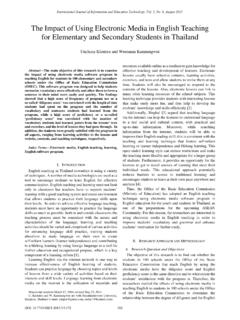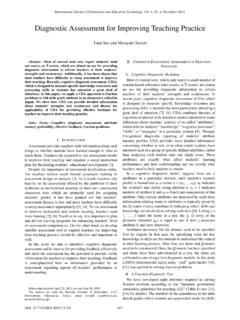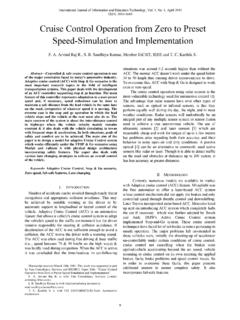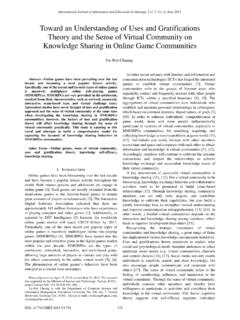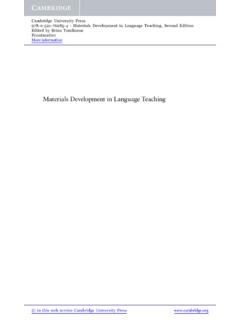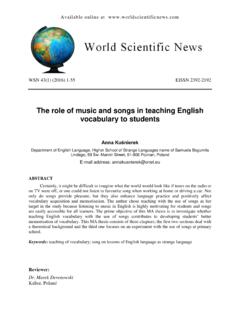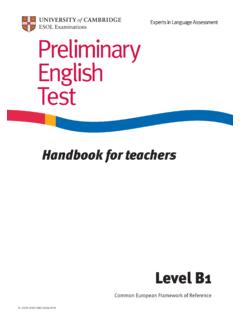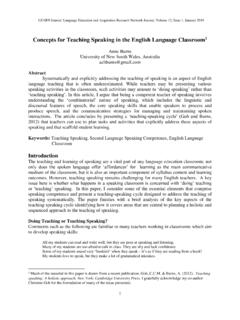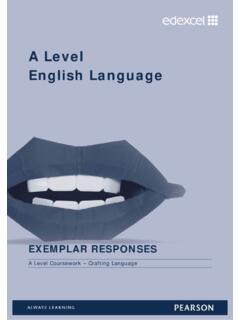Transcription of The Use of Literature in the Language Classroom: Methods ...
1 Abstract Literature in a Language classroom provides enough space for the learners to comment, justify and mirror themselves. By using literary text the Language class can turn out to be lively and motivating. This article s main purpose is to provide you with the appropriate information through a Literature review concerning the use of literary texts in Language learning as well as its benefits. Furthermore, in this article, there are presented the different aspects of Literature Methods based on theories and organized activities according to a group of Greek intermediate students. Index Terms Activities, children, English, Methods . I. INTRODUCTION Bearing in mind that in the last decade, there has been an upsurge of interest in how literary texts can be used with the Language learner, this article s main purpose is to suggest ways of using Literature in the classroom helping the students improve the English Language .
2 This can be achieved through specific activities based on a literary text ( Little Women by Louisa May Alcott) and, of course, by adjusting the text with a particular group of students (intermediate Greek students). Basically, we will focus on the question of what is Literature , the multiple values of teaching Literature in the classroom, how Literature helps the student develop the basic skills (speaking, writing, reading), and the reasons for choosing this particular text and finally, provide the exercises originating from this text. II. WHAT IS Literature ? There are many different definitions given to the above question. Here are some given by teachers from all over the world [1]: 1) Literature is the feelings and thoughts in black and white. 2) Literature is a world of fantasy, horror, feelings, visions .. put into words. Here are also other quotations which define Literature .
3 Literature could be said to be a sort of disciplined technique for arousing certain emotions [2]. Great Literature is simply Language charged with meaning to the utmost possible degree [3]. According to Boas [4] Literature is the record of experience interpreted by personality that behind every book which the race has preserved is a human being s eager effort Manuscript received November 10, 2013, revised January 22, 2014. Koutsompou Violetta-Irene is with City Unity College, Athens, Greece (e-mail: to give life meaning, to create beauty, to express vivid emotions and ideas, to make men aware of themselves and the life they lead . The above extract presents an integrated meaning of the value and the importance of Literature . III. HISTORICAL REVIEW Literature and Language are closely related and this is a fact none can deny. Literature is constituted by Language and it represents one of the most recurrent uses of Language .)
4 Language and linguistic analysis can also be employed to access Literature from the learner s point of view. Brumfit and Carter [5] already emphasized the role of Literature as an ally of Language . This technique is by no means novel, since Literature has been a widely used teaching tool in different Language teaching Methods . However, here the perspective changes giving more relevance to the literary text as a work of art. First of all, let us go over the changing role of Literature in the tradition of second Language teaching to end with an account of its current situation within the communicative approach. In the grammar translation method, Literature was the central component. Literary texts of the target Language were read and translated, used as examples of good writing and illustrations of the grammatical rules [6].
5 The focus of this teaching method was on form, on learning the rules of grammar and the lexical items as they appeared in the text. There was no literary interest, nor interest on content. After this method fell in disuse, literary texts also went forgotten for teachers of second languages. For the structural approaches to Language teaching , Literature was discredited as a tool, because it represented the old tradition. The functional-notional method ignored Literature , because in this method the importance lies on communication and they present authentic Language samples. Literature was not considered either to have a communicative function or to be authentic example of Language use. Nonetheless, in the last decade or so the interest in Literature as one of the most valuable Language teaching resources available has revived remarkably [7].
6 This is in consonance with the new currents within the communicative approach that see in reading Literature the perfect realization of their principles namely developing communicative competence , that is teaching learners to communicate in the second Language and accounting for real, authentic communicative situations [8]. Literature reading is, no doubt, a communicative activity and literary texts are who could nowadays deny such thing, authentic examples of Language use. Many authors, among them Brumfit and Carter [9] and Lazar [10], reject the idea of the existence of a specific literary Language and claim that the Koutsompou Violetta-Irene The Use of Literature in the Language Classroom: Methods and Aims 74 DOI: Journal of Information and Education Technology, Vol. 5, No. 1, January 2015language used in literary texts is common Language with a high concentration of linguistic features like metaphors, similes, poetic lexis, unusual syntactic patterns, etc.
7 These are not Literature specific since these features also appear in ordinary Language use and also in nursery rhymes, proverbs or publicity slogans, just to cite a few examples, however, in Literature these show a higher incidence. We talk therefore, of a literary use of Language . IV. CRITERIA FOR USING Literature There are three main criteria that justify the use of Literature as a second Language teaching tool [11]. Firstly, the linguistic criterion defends that Literature should be used in Language teaching , because it provides the learner with genuine, authentic samples of Language , and also with real samples of a wide range of styles, text types and registers. It is extremely important for foreign Language learners to be trained in a variety of registers, styles and genres and to be able to differentiate the purpose of each of them. These different manifestations of Language are not only distinctive linguistically, but also socially, they all have a social communicative function.
8 This has to do with the notion of adequacy. It refers to the fact that a message needs to be linguistically correct and situationally appropriate, as regards not only its content, but also its form for a more detailed account on the notion of adequacy and its relationship to communicative competence. The second criterion is methodological and refers to the fact that a literary text has multiple interpretations, these generate different opinions among the learners and this leads to real, motivated interaction with the text, with the fellow students and with the teacher. Interaction is one of the bases of the communicative approach which defends that it is by interacting, by communicating, that the Language is learned. From the methodological point of view, further aspects that favor the use of Literature in the Language classroom are the active role of the learner and the literary text as the central focus of attention.
9 Learners become active, autonomous, and central to the learning process. One aspect of special importance within the communicative approach is the idea of Literature supplying the learner with cultural information about the country whose Language they are learning. Our response to the cultural aspect as reflected in Literature should be critical. Lastly, the motivational criterion is of great relevance because the literary text shows the real feelings of the writer and this generates a powerful motivation in the learner. With the literary text the student accesses this personal experience, if she is touched by the theme and provoked, she will be able to relate what she is reading to her world, to what she knows and feels. Designing stimulating activities that motivate the learners is the greatest challenge for Language teachers, and Literature has a strong motivating power due to its calling on to personal experience.
10 V. WHY USE Literature ? The purpose of using Literature in a Language classroom is to make the class interactive and it can be stated that an interactive class can obviously improve communicative competence of the learners and keep a lasting impact on their mind. Such a class can enhance the critical thinking abilities of the learners and at the same time maintain a learner centre environment. Literary texts are a rich source of classroom activities and can surely prove to be very motivating for learners. No wonder the use of literary pieces play a significant role in English Language teaching . Literature opens a new world to the students. It cultivates the critical abilities of the students. It encompasses every human dilemma, conflict and yearning unraveling the plot of a short story is more than an automatic exercise. It demands a personal response from the learners and encourages them draw on their own experiences.
